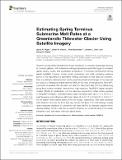Files in this item
Estimating spring terminus submarine melt rates at a greenlandic tidewater glacier using satellite imagery
Item metadata
| dc.contributor.author | Moyer, Alexis N. | |
| dc.contributor.author | Nienow, Peter W. | |
| dc.contributor.author | Gourmelen, Noel | |
| dc.contributor.author | Sole, Andrew J. | |
| dc.contributor.author | Slater, Donald A. | |
| dc.date.accessioned | 2020-03-13T10:30:06Z | |
| dc.date.available | 2020-03-13T10:30:06Z | |
| dc.date.issued | 2017-12-15 | |
| dc.identifier | 266866453 | |
| dc.identifier | 66d96aee-980c-4d4b-b9d8-7f899f4e1423 | |
| dc.identifier | 85041054999 | |
| dc.identifier.citation | Moyer , A N , Nienow , P W , Gourmelen , N , Sole , A J & Slater , D A 2017 , ' Estimating spring terminus submarine melt rates at a greenlandic tidewater glacier using satellite imagery ' , Frontiers in Earth Science , vol. 5 , 107 . https://doi.org/10.3389/feart.2017.00107 | en |
| dc.identifier.issn | 2296-6463 | |
| dc.identifier.other | ORCID: /0000-0001-8394-6149/work/70619160 | |
| dc.identifier.uri | https://hdl.handle.net/10023/19649 | |
| dc.description.abstract | Oceanic forcing of the Greenland Ice Sheet is believed to promote widespread thinning at tidewater glaciers, with submarine melting proposed as a potential trigger of increased glacier calving, retreat, and subsequent acceleration. The precise mechanism(s) driving glacier instability, however, remain poorly understood, and while increasing evidence points to the importance of submarine melting, estimates of melt rates are uncertain. Here we estimate submarine melt rate by examining freeboard changes in the seasonal ice tongue of Kangiata Nunaata Sermia (KNS) at the head of Kangersuneq Fjord (KF), southwest Greenland. We calculate melt rates for March and May 2013 by differencing along-fjord surface elevation, derived from high-resolution TanDEM-X digital elevation models (DEMs), in combination with ice velocities derived from offset tracking applied to TerraSAR-X imagery. Estimated steady state melt rates reach up to 1.4 ± 0.5m d-1 near the glacier grounding line, with mean values of up to 0.8 ± 0.3 and 0.7 ± 0.3m d-1 for the eastern and western parts of the ice tongue, respectively. Melt rates decrease with distance from the ice front and vary across the fjord. This methodology reveals spatio-temporal variations in submarine melt rates (SMRs) at tidewater glaciers which develop floating termini, and can be used to improve our understanding of ice-ocean interactions and submarine melting in glacial fjords. | |
| dc.format.extent | 2739806 | |
| dc.language.iso | eng | |
| dc.relation.ispartof | Frontiers in Earth Science | en |
| dc.subject | Ice/ocean interactions | en |
| dc.subject | Remote sensing | en |
| dc.subject | Submarine melt | en |
| dc.subject | TanDEM-X | en |
| dc.subject | Tidewater glaciers | en |
| dc.subject | GE Environmental Sciences | en |
| dc.subject | Earth and Planetary Sciences(all) | en |
| dc.subject | 3rd-NDAS | en |
| dc.subject | SDG 14 - Life Below Water | en |
| dc.subject.lcc | GE | en |
| dc.title | Estimating spring terminus submarine melt rates at a greenlandic tidewater glacier using satellite imagery | en |
| dc.type | Journal article | en |
| dc.contributor.institution | University of St Andrews. School of Geography and Geosciences | en |
| dc.contributor.institution | University of St Andrews. School of Geography & Sustainable Development | en |
| dc.identifier.doi | 10.3389/feart.2017.00107 | |
| dc.description.status | Peer reviewed | en |
This item appears in the following Collection(s)
Items in the St Andrews Research Repository are protected by copyright, with all rights reserved, unless otherwise indicated.

